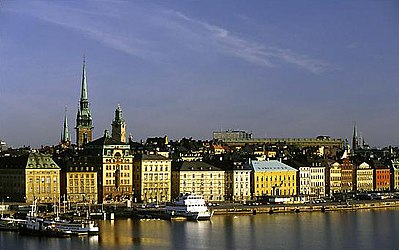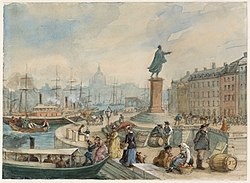Skeppsbron
Several alleys connects Skeppsbron to the thoroughfare Österlånggatan: Slottskajen, Lejonbacken, Slottsbacken, Telegrafgränd, Skeppar Karls Gränd, Bredgränd, Kråkgränd, Nygränd, Brunnsgränd, Skottgränd, Stora Hoparegränd, Drakens Gränd, Ferkens gränd, Gaffelgränd, Johannesgränd, Packhusgränd, Tullgränd, Norra Bankogränd, Södra Bankogränd, Norra Dryckesgränd, Södra Dryckesgränd, Slussplan Skeppsbron is mentioned as Stadzbron in 1592, skeepzbroon in 1647, and finally appears as Skeppsbron in 1961.
[5] Without a number : Stockholm Palace, and opposite to Slottsbacken the statue of Gustav III (1746–1792) by Tobias Sergel (1740–1814) inaugurated in 1808.
The statue was inspired by the Apollo Belvedere marble, and the artist described his work as "is in movement, holding a helm in one hand, while offering an olive branch signifying peace with the other.
"[6][7] N.20, Brandstodsbolagets hus ("House of the Fire-insurance Company"), designed by Isak Gustaf Clason (1856–1930) and built by the turn of the century 1900 in the style of Tessin the Younger.
[9] The red granite sculpture 'Sea god' (Sjöguden) by Carl Milles (1875–1955) found on the quay, is from 1913 and depicts a monster with a broad smile pressing a bashful mermaid to his chest.




